updated 05/08/2014
![]()
updated 05/08/2014
St. Bridget Catholic Church History, photos & misc. records Postville, Post township |

St. Bridget Catholic Church
Introduction.
1872-1972 marks one hundred years in the life of St. Bridget Parish, Postville, Iowa. One hundred yeras is a relatively short period of time in the annals of history. Narration of the progress of a parish and the people whose lives were influenced by that parish during those years is an extensive undertaking.
Writing a history of St. Bridget Parish is complicated by a lack of accessible records. To 1910, St. Bridget Parish was attached as a Mission Parish to one or other of the surrounding parishes. The early records are intermingled with those of *Prairie du Chien, Wexford, McGregor, Monona, Clermont, Ossian, and others. For example, the Parish Register of St. Bridget Parish has an entry sent from Sacred Heart Church, Manly, Iowa by Rev. C.A. Ferring on May 20, 1942, "I am sending on the above names found in a baptismal register left here by a traveling missionary." Three Baptisms at St. Bridget Church, Postville, by Rev. P.X. Shulah are listed. Two on May 11, 1879, for Anna Rosalia Nitsech and William Thomas Horgan. The Baptism of Mary Elizabeth Hamilton is listed on May 21, 1879.
Beginnings.
Trickling waters nourished grasses waving in the breezes of leaves rustling in the wind in forming the fertile soil of what is now the joining area of the four counties of Northeast Iowa. Nature nodded in silent assent that all God created was good.
Later Indians trod upon the grass-carpeted prairie hunting bison or traveling to the Father of Waters to the east.
The French missionary Jacques Marquette, S.J., and his French explorer companion Louis Joliet, in the vicinity of McGregor, were the first white men of record to look upon Iowa. They were followed over the years by French Canadian explorers and fur traders, who established Prairie du Chien, Wisconsin before 1800.
The first documented settlement of white people in Allamakee County was in connection with the Yellow River Indian Mission in 1835. The Yellow River Mission was closed in 1840 and moved to Fort Atkinson. Midway between Fort Crawford and Fort Atkinson, the Army built a stopping place. In 1841, the army deeded the stopping post to Joel Post and his wife Zerniah. Thi third settlement in Allamakee County was the location of the first county post office in January, 1849.
Little is preserved of the first Catholics in the Postville area. Mention is made of the Sons of Erin in the 1840's and of the Irish and the French in the 50's. By place of origin these would be identified as Catholics. Prairie du Chien had an early Catholic presence with the establishment of Saint Gabriel's Church. It is known that priests from Prairie crossed over to visit the Catholic families west of the Mississippi. It is likely that they used the old Military Road to Postville.
With the arrival of Father Thomas Hore and the families he brought with him from Ireland, St. George's Church was founded at Wexford in June, 1851. This was the first Catholic Church in Allamakee County. Father Hore attended to the Catholics of Wexford and those of the county and surrounding counties for several years, until he returned to Ireland. Father Hore traveled extensively in the area. It is likely that both he and priests from Prairie du Chien would have been in the Postville area at this time.
Father Louis DeCailly attended to the Catholics of McGregor and the surrounding area from early in 1856 to March 1, 1858. He was followed by Father Richard Nagle on July 18, 1858, who lived in a farm house adjacent to Monona and was appointed to care for the Catholics of McGregor, Monona, Cherry Mound, Elkader, Postville, and Clermont. He later moved to McGregor and served in the area about ten years.
The coming of the railroad to Postville in 1864, and five years later, the extending of what is now known as the Milwaukee Road from Marquette, Iowa, brought an influx of people to the Postville communtiy. Many of these were immigrants from Ireland and Germany.
In the 'Centennial History of the Archdiocese of Dubuque 1837-1937', it states, "Old residents tell of Mass being celebrated once or twice in a box car and later in the home of Patrick Murphy. A Father Heneberry came on horseback and stayed overnight in the home of Frank Steele. The Rev. Richard Nagle stationed at McGregor visited this place at intervals between 1856-1868 (actually, 1856-58 was by Father Louis DeCailly), offering Mass in the homes. He was succeeded by the Rev. B.C. Lenihan, also a resident of McGregor. His ministrations continued from 1868-1871. In that year, Father Charles Toner came to Monona as its first resident pastor." He served the people of Monona, Postville, and Ossian.
In 1871, there is reference to a Catholic Society in Postville with the implication that it was then in existence for several years. Encouraged and supervised by Father Charles Toner, the Catholic Society erected a good sized frame church (36X70) at a cost of $2,500 in 1872. This church dedicated to St. Bridget was located at what is now the corner of Ogden and Murdock Streets.

St. Bridget's Catholic Church
In 1873 Father J.F. Brady was assigned as the first resident pastor of St. Francis de Sales Church, Ossian. From 1873 to 76, he also had charge of Postville and Monona.
From 1876 to 79, Father D.H. Murphy of Ossian also administered to the people of Postville and Monona.
Care of the Catholics in Postville from 1879 to 1889 was entrusted to the pastors of Clermont. These included Fathers E. O'Sullivan, D.H. Murphy, F.D. Brennan, L.H. Burns, and John Hackett.
In 1889, the mission of Postville was made again a part of the Monona parish. Father J.F. Corbett of Monona died a few months later and was followed by his brother, Father P. Corbett to 1893, when Father M.. Hogan began his 17 years of direction at St. Bridget Parish. In the Centennial History, it states that Father Hogan received charge of the Monona parish and with it Postville from Archbishop Hennessy. He came to Postville every third Sunday.
Toward the end of the year 1910, Father H. Felder was appointed first resident pastor of Postville by the Most Rev. John J. Keane. Father Felder felt the missionary call and remained only a year.
Archbishop James J. Keane was appointed to become Archbishop of Dubuque, on August 11, 1911. Shortly after his installation, Archbishop Keane selected the Rev. John J. Clune, then assistant pastor of Sacred Heart Churc, Rockwell, as the next pastor of St. Bridget Church, Postville.
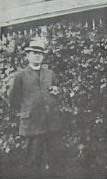
Rev. J.J. Clune
Beginning with Father Clune's pastorate, the parish records are continuous. The old Baptism Register is dated November 1, 1911, with the first entry that of Loretta Horgan, daughter of John Horgan and Mary Thill, born November 24, 1911, and baptized December 3, 1911, with Patrick Horgan and Barbara Thill as sponsors and Rev. J.J. Clune as officiating priest. It is interesting to note that the first three entries for 1912 are prominent men of the parish and community today, namely: Joseph Steele; Daniel McNeil; and Edward Kozelka.
The first entry in the Marriage Register is that of Daniel McNeil and Nora Palas on April 30, 1913.
The Register of First Communions, Confirmations, and Deaths was not commenced until the 1920's.Incorporation.
Under Father Clune the Catholic Society was incorporated under Iowa Statute on Dec. 18, 1911, at St. Bridget's Church of Postville. In part, the articles of incorporation read "Therefore, know all men by these presents, that we, Most Rev. James J. Keane, Archbishop aforesaid, Rev. Roger Ryan, Vicar General aforesaid, Rev. John Clune Pastor and Vice President as aforesaid, and B.C. Fleming and Joseph Steel lay members of said Church as aforesaid, do hereby associate ourselves together for the purpose of becoming incorporated under the name and for the purpose herinafter stated, pursuant to the provisions of Chapter 2 of Title IX of the Code of 1897 of the State of Iowa ... The general purpose of this corporation is to take charge of and manage all the temporal affairs of the Catholic church in said Postville; to promote the spiritual, educational, and other interests of said Catholic Church therin, including all charitable, benevolent, elsemosynary work of said Church therein; to take charge of, hold, and manage all property ... the corporation may require." Upon inquiry it was learned that there were two men with the name "Joseph Steele". The grandfather of the present Joseph B. Steele, dropped the final "e" to avoid confusion.
The Parish Directors since the incorporation of the parish are as follows:
1912-1915: B.C. Fleming, Sec. and Joseph Steel, Treas.
1916-1924: B.C. Fleming, Sec. and John E. Horgan, Treas.
1924-1934: A.J. Schuler, Sec. and John E. Horgan, Tr.
1935: T.H. Burns, Sec. and John E. Horgan, Tr.
1936: M.E. Kaliman, Sec. and John E. Horgan, Tr.
1937-1942: Joseph B. Steele, Sec. and John E. Horgan, Tr.
1942-1956: James W. Steele, Sec. and John E. Horgan, Tr.
1956-1972: Dr. Raymond T. Martin, Sec., Daniel J. McNeil, elected Oct. 29, after resignation of B.J. Waters.
When Father Clune came to Postville, there was no parish rectory. Plans were made to construct a parish house. It was determined that it would be an advantage to have the church in the middle of town. Daniel McNeil, Sr., purchased lots 22 and 23 of block 21 in Lawler's addition in 1912 for $1,000 and donated them to St. Bridget's for church purposes. The financial statement of 1912 shows an entry of $8.00 for examination of the abstract. The financial statements of 1913 states "House in course of construction, insured by contractor." Financial statements of the parish are on record from 1912 to the present.
The annual report of 1914 lists the expenditure of $4,895.88 for the Parish house. This report also lists expenditure of $1,212.54 for moving church, foundation, etc. Revenues for 1914 show, in addition to the usual incomes, subscriptions in the amount of $5,198.20 and $577 from sale of the lots where the old church was located. A deficit of $394.20 was reported for the year, which was cleared in 1915 under the heading of donation.
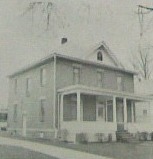
Rectory
Under the date of October 14, 1913 "The Volksblatt," the Postville newspaper reads: Excavation was begun by St. Bridget's Catholic Church during the week near the fire station. They plan to move their church from the north edge of town to their property next to the new parish recory.
Again we read in "The Volksblatt" under the date of October 2, 1914: Parishioners of St. Bridget's Catholic Church had a bee this week and completed the task of improving their property following the moving of the structure from the north side of town to its present site near the fire station.
The 'Centennial History' states: " ... the church was moved and virtually built anew. Substantial gifts to the parish came from Christine Steele, Joseph Steele, Sr. and John Lydon."Great jubilation came to the newly rebuilt church and its parish community the following year with the celebration of the First Solemn Mass of Father Frederick B. Steele on June 10, 1915. Father Steele had been ordained to the priesthood at St. Paul, Minn. on June 8, 1915 by the famed Archbishop John Ireland. Father Steele was called in death to his eternal home on January 17, 1920, shortly after he became pastor of Our Lady of Mount Carmel Church, Lawler.
Additional improvements in the church continued in 1915 in the amount of $963.34, which was paid by an additional $908 in subscriptions. Expenditure was made of $450 in 1917 for purchase of new pews.
Father Clune was transferred to Lawler in 1922. However, as he had an assistant pastor there, he returned to Postville for masses on Sundays and Holy days for the rest of the year until Father Frank Renier was assigned to the parish following his return from serving as a chaplin in the army. Sometime after May 10, 1923, Father Reiner was unable to continue due to poor health. Father John Hehir of Clermont cared for the parish temporarily until the fall of 1923.
~*~
*notes - Prairie du Chien is in Crawford co. Wisconsin; McGregor & Monona are in Clayton co. Iowa; Clermont is in Fayette co. Iowa; and Ossian is in Winneshiek co. Iowa
~ source: The History of St. Bridget's Parish 1872-1972
~ transcribed by Sharyl Ferrall for Allamakee co. IAGenWeb
~*~*~
|
~*~*~
The New St. Bridget's Catholic Church
 St. Bridget's Catholic church 1872-1970
|
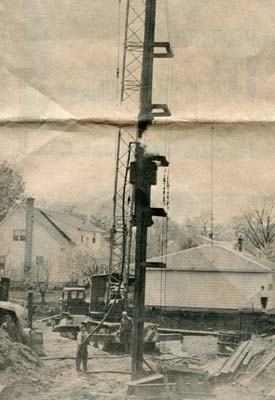
|

|
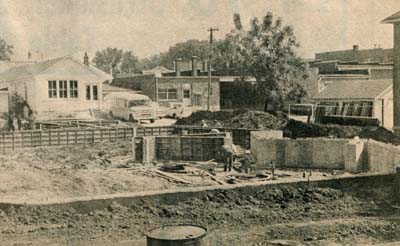 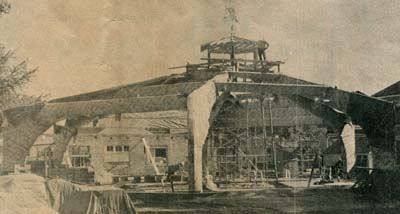 |
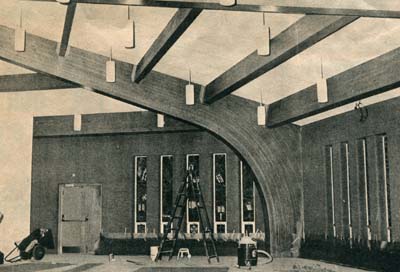
|

|
~source: Postville Herald, December 16, 1970
~contributed by Connie Ellis
~*~*~
Dedication of the new church, Sunday,
December 13, 1970
Open house, January 10, 1971
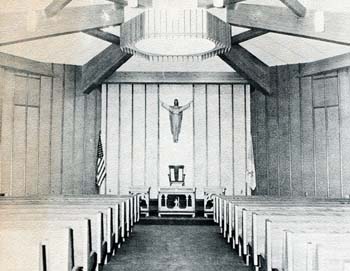
The location of the new St. Bridget Church in Postville is on the same site as the former church and extending westward over the lot where the Postville Public LIbrary formerly stood. The Winona cut limestone facade of the hexagonal church area faces south on Williams Street.
A windowed cupola directly over the altar refracts light through the inverted dome over the altar. A thinline spire surmounting the cupola is topped by a cross. Interior design and appointments of the church follow the comtemporary style of the exterior. Sanctuary furnishings are constructed of stained red oak with slabs of cut Dubuque limestone. Statues presenting the Risen Christ in the center and the Blessed Mother and Christ Child and St. Joseph the Worker on either side, and the fourteen stations of the Cross are specially made woodcarvings in camphor wood by the artists of St. Joseph Carpenter Shop, Taiwan, Republic of China. Eighteen distinctive faceted jewel glass and epoxy windows give added dimension to the nave walls.
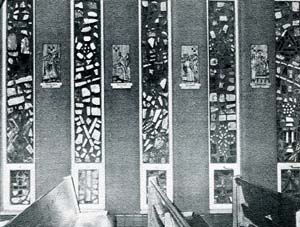 |
 |
Architect: W-Smith Architectural and Engineering Services, Winona, Minnesota
Mechanical & Electrical Engineers: Olson, Emanuelson and March, Minneapolis, Minnesota
Sound Engineering & Installation: Rt. Rev. Msgr. Vernon J. Peters, Ossian, Iowa
Faceted Glass: Morris Lillethun, Glass Crafts, LaCrosse, Wisconsin
Carpeting: McTaggarts, Elkader, Iowa
Sanctuary furnishings: Fabricius, Dubuque, Iowa
Pews: Tuohy Church Furniture, Chatfield, Minnesota
General Contractor: Nelson Construction Co., Caledonia, Minnesota
Mechanical-Heating: Stone Plumbing & Heating, Waukon, Iowa
Electrical: Brown Electric & Appliance, Decorah, IowaHistory
1871 - Milwaukee Railroad construction brought an increased number of Catholics to the Postville area. Mass was first offered in a boxcar and later in the Murphy, Steele and other homes.
1872 - Original church built by the Catholic Society at Ogden and Murdock Streets
1910 - First resident pastor, Father H. Felder
1911-1922 - Father J.J. Clune, pastor
1913 - Parish House built at present location on McNeil property donation
1914 - Church moved to McNeil property and substantially reconstructed
1923-1944 - Father Patrick Hogan, pastor
1935 - Church enlarged by addition of Sanctuary and Sacristy
1944-1962 - Father Francis Vallaster, pastor
1960 - Discussion of need for new church
1962-1967 - Father Joseph A. Sullivan, pastor
1964 - Advisory committee for building project: Daniel J. McNeil, Dr. Raymond T. Martin, Charles Fishback, William A. Kneeland, Edward W. Kozelka, Harold Rosenbaum, Joseph B. Steele and Bertie Waters.
1965 - Building fund drive begun
1967 - Parish Council elected; Members (present and past): Daniel J. McNeil, Dr. Raymont T. Martin, Mrs. Leo Berns, Mrs. Daniel Bruns, George Burger, Charles Fishback, President: William J. Huinker, Vice-President: Mrs. Robert Jones, Mrs. Harry Landt, Mrs. Merle Lange, Secretary: Harold Rosenbaum, Raymond Spinner
1967 - Father Cletus J. Hawes, pastor
1969 - January 1970 - Purchase of adjacent property, contracted with architect, final approval by Archbishop James J. Byrne and Archdiocesan Building Committee and open of bids. Low bids were accepted.
March 29, 1970 - Easter Sunday, last Masses in the old church building; services then moved the parish center into the I.O.O.F. Hall until the new church was completed
April 19 & 20, 1970 - Groundbreaking and construction begun~source: Booklet of the St. Bridget's Catholic church Dedication, Sunday, December 13, 1970
~contributed by Connie Ellis
~*~*~
|
~*~*~